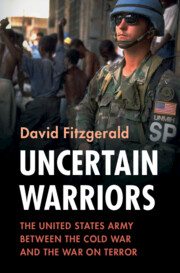Book contents
- Uncertain Warriors
- Military, War, and Society in Modern American History
- Uncertain Warriors
- Copyright page
- Dedication
- Contents
- Figures
- Acknowledgements
- Introduction
- 1 The Post-Vietnam Recovery, Operation Desert Storm and the Veneration of the Volunteer Soldier
- 2 Gender, Sexuality and the Profession of Arms
- 3 Warriors Who Don’t Fight
- 4 Downsizing, Recruiting and Debates over Military Service
- 5 Technological Transformation and the American Soldier
- 6 The Warrior Ethos
- Epilogue
- Index
6 - The Warrior Ethos
Published online by Cambridge University Press: 19 October 2023
- Uncertain Warriors
- Military, War, and Society in Modern American History
- Uncertain Warriors
- Copyright page
- Dedication
- Contents
- Figures
- Acknowledgements
- Introduction
- 1 The Post-Vietnam Recovery, Operation Desert Storm and the Veneration of the Volunteer Soldier
- 2 Gender, Sexuality and the Profession of Arms
- 3 Warriors Who Don’t Fight
- 4 Downsizing, Recruiting and Debates over Military Service
- 5 Technological Transformation and the American Soldier
- 6 The Warrior Ethos
- Epilogue
- Index
Summary
As the Army found itself caught up in debates about a ‘kinder, gentler military’, Army leaders reacted by emphasising cultural change. Part of this cultural shift came from the bottom up, as commanders in elite combat units showed a new interest in the psychology of killing and brought in consultants to lecture their instructors on how to more effectively inculcate a willingness to kill. Much of it came from the top, though. General Eric Shinseki controversially mandated that all soldiers would wear black berets as their working headdress to symbolise a new Army culture, and he commissioned a study on the ‘warrior ethos’ and begin to enshrine that ethos into Army doctrine and training. This warrior ethos – the idea that all soldiers are de facto heroic and potential Rangers – had the goal of democratizing notions of soldiering within the Army. However, not only did the warrior ethos require all soldiers to psychologically orientate themselves towards combat, but one of the unintended consequences of the decision may have been to help to put the American soldier a little higher on the pedestal of public opinion and inadvertently widen the gap between soldier and citizen.
Keywords
- Type
- Chapter
- Information
- Uncertain WarriorsThe United States Army between the Cold War and the War on Terror, pp. 216 - 250Publisher: Cambridge University PressPrint publication year: 2023

